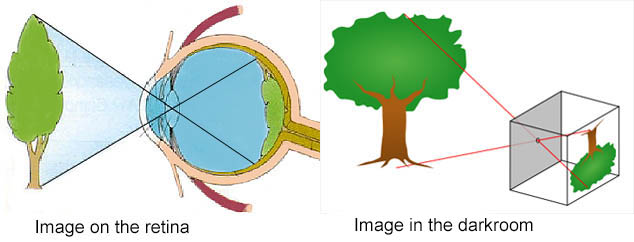The camera and the eye works in a very similar way, they have many similarities.

Eye
- Pupil: it is a hole located in the center of the iris of the eye that allows light to enter the retina and its purpose is to control the amount of light by controlling its size. A different amount of light changes the pupil’s size and the pupil gets wider in the dark and narrower in the light. In the camera the diaphragm works as pupil;
- Iris: it is a thin, circular structure in the eye, responsible for controlling the diameter and size of the pupil. In the camera the iris is the diaphragm ring that control its size;
- Cornea: Is the first lens of the eye’s optical system, it cannot change its shape because it is stiff. In the camera the frontal lens works as Cornea;
- Retina: Is the place where the images are set up. In the camera the sensor (or film) works as Retina. Image on the retina is inverted (thus upside-down) and it is rotated by the brain.
SLR Camera
The light (the image) enters from the frontal lens and the mirror sends it to prism and it sent a reverse image in the eyepiece. It allows to the photographer to se the image. Lens: is the camera�s optical system, it sends a reverse image to the mirror that is usually lowered;
Mirror: it is usually lowered to allow see the images trough the eyepiece. It rises only during the shooting so the sensor can catch the image. The image on the mirror is inverted, and it is straighten by the prims ;
Pentaprism: it is used to rotate the projected image on the mirror;
Eyepiece: its goal is to put the image to infinite, so that it is possible to look inside the camera for a long time without tiring the eyes.
Shutter: it provides the light to the sensor, and it opens only during the shooting for a specific time. The shutter, like the diaphragm, controls the amount of light that must to go to the sensor;
Diaphragm: it controls both the depth of field and the amount of light. It is made of series of blades that when they open and close change both depth of field and amount of light.
Considerations
The camera and the eye works in a very similar way, they use the same concept. Both the eye and the camera are a darkroom, having a hole, from which the light enters. Light from an external scene passes through the hole and strikes a surface inside, where it is reproduced, rotated 180 degrees (thus upside-down). In the human eye the image is reproduced onto the retina, and it is rotated by the brain , in the camera on the digital sensor or film, and it is rotated by the pentaprism.
